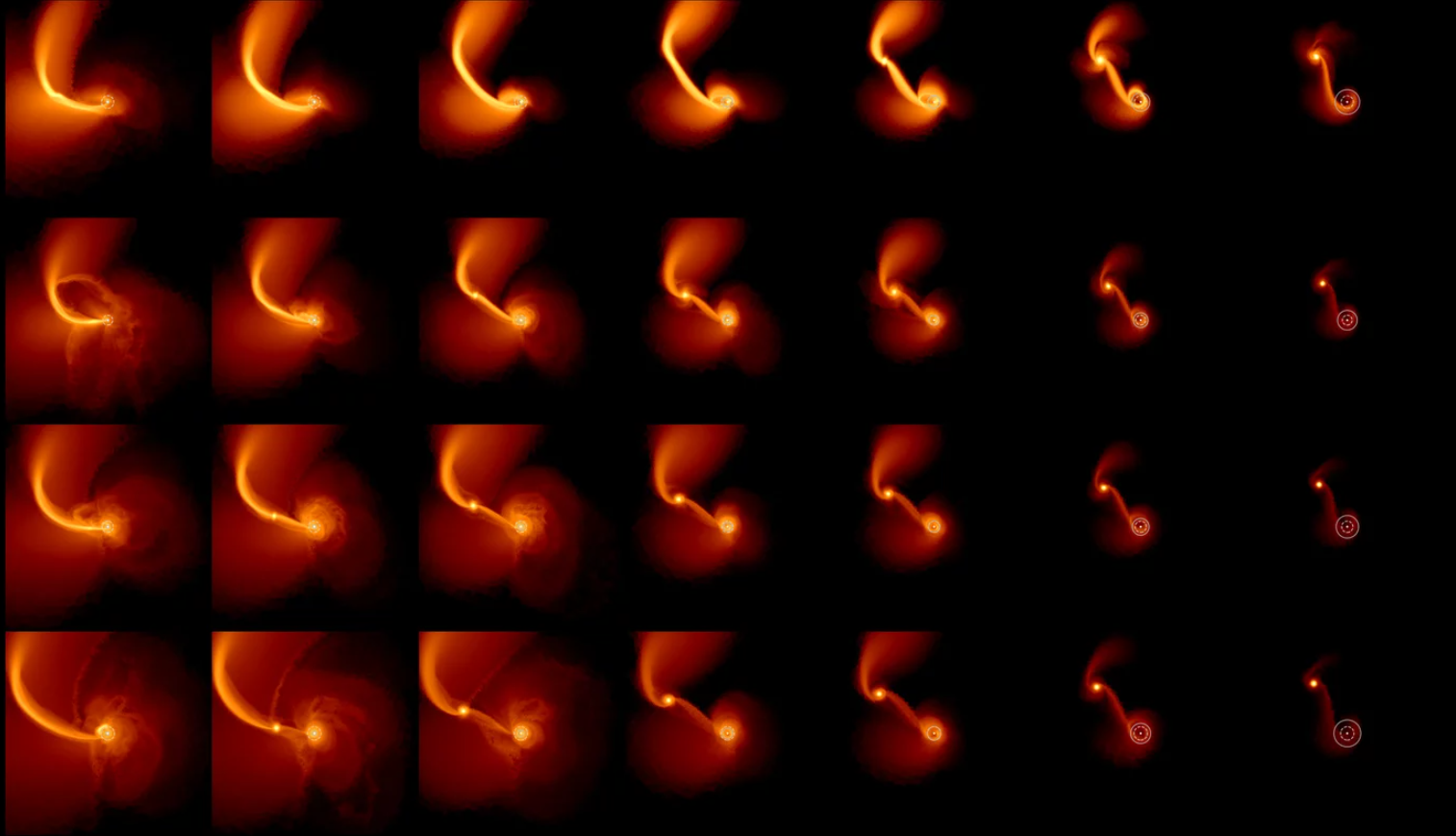In dense stellar environments, interactions between stars and stellar-mass black holes should occur frequently. Through hydrodynamical simulations, researchers at MPA have explored how stars are disrupted in such encounters, varying key parameters such as stellar and black hole masses, stellar age, and approach distance. The study quantifies the impact of these initial parameters on stellar remnants’ masses, spins, and trajectories, offering insights into cluster dynamics and providing best-fit formulae for post-disruption parameters.
The centers of globular and nuclear star clusters are the densest stellar environments in the Universe. Due to this high density, one can expect numerous gravitational encounters between stellar objects, including black holes with masses of about 10-100 solar masses. A particularly close approach of a star towards a stellar-mass black hole can result in the distortion or disruption of the star due to the intense tidal force around the black hole. Such a phenomenon is called a ‘micro tidal disruption event’ or μTDE. The prefix ‘micro’ distinguishes it from the more widely studied TDE involving a supermassive black hole (i.e. with a mass greater than a million times the Sun). The TDEs that are due to supermassive black holes have garnered significant interest as transients at optical, UV, and X-ray wavelengths, with more than 100 confirmed observations. Although there have been no confirmed observations of μTDEs as of 2023, future large-scale transient surveys like LSST hold promise.

Detailed studies of μTDEs are crucial for understanding the gravitational dynamics of dense star clusters and the growth of black holes in these clusters. The trajectory of a star undergoing a partial disruption is altered due to mass loss (A full disruption leads to the destruction of the star). Approximately half of the mass lost from the star becomes unbound while the other half stays close to the black hole. This material eventually accretes onto the black hole resulting in the growth of its mass. Therefore, N-body and other simulations need to take these disruptions into account to properly model the long-term dynamics of a star cluster, especially its central dense region. This accuracy can be attained through detailed hydrodynamics simulations of star – black hole encounters.
In this work, we simulated a suite of 58 hydrodynamical partial μTDEs using the 3D moving-mesh code AREPO. Unlike previous studies on μTDEs, we employed realistic stellar models generated through the stellar evolution code MESA. We varied the masses of both the star (0.5 and 1 solar masses) and the black hole (10 and 40 Solar masses), the age of the star (zero-age, middle-age, and terminal-age main sequence), and the distance of closest approach between the two. Our results then ranged from almost no mass loss to full disruption of the star.
Assuming an initially non-rotating star and a parabolic encounter between the star and the black hole, our primary aim was to quantify how the masses, spins, and trajectories of the stellar remnants depend on these initial parameters.

Pavan Vynatheya, PhD student in the stellar department at MPA
This sequence shows a simulation of how a Sun-like star is disrupted by a black hole of 10 solar masses. The star approaches the black hole on a parabolic orbit, with a closest approach distance of approximately the star’s radius. The star spins up due to the torque from the black hole, and around 5% of the star’s mass is lost to the tidal streams, half of which becomes bound to the black hole.
We found that the amount of mass lost from a star decreases roughly exponentially with increasing distance of closest approach; i.e. the farther away a star passes the black hole, the less matter it loses. The stellar age also plays a role – main-sequence stars of different ages disrupt differently even when all the other initial parameters are the same. The more evolved a main-sequence star is, the higher its central density as it contains more core helium from hydrogen burning. It is therefore much harder to fully disrupt an older main-sequence star compared to a younger one. In addition, the stellar remnant is spun up due to torque from the black hole. A closer approach results in a higher torque, which translates to a higher angular momentum gained by the stellar remnant.
Finally, the initial parabolic trajectory of the star changes due to the combined effects of stellar tides, asymmetric mass loss, spin-up of the remnant, and ejecta energy. In accordance with previous studies, the remnant can either be bound to the black hole (eccentric orbit) or escape from it (hyperbolic orbit). In the former case, the remnant would then undergo repeated disruptions until it is completely ripped apart. In general, the remnant becomes unbound when the star loses a significant fraction of mass in the disruption and the star-black hole mass ratio is skewed, i.e., the black hole is much heavier than the star.
The results from our suite of simulations are available in the form of best-fit formulae for the post-disruption parameters. These can be incorporated into cluster simulation codes to better model elusive star-black hole encounters.

Comments are closed